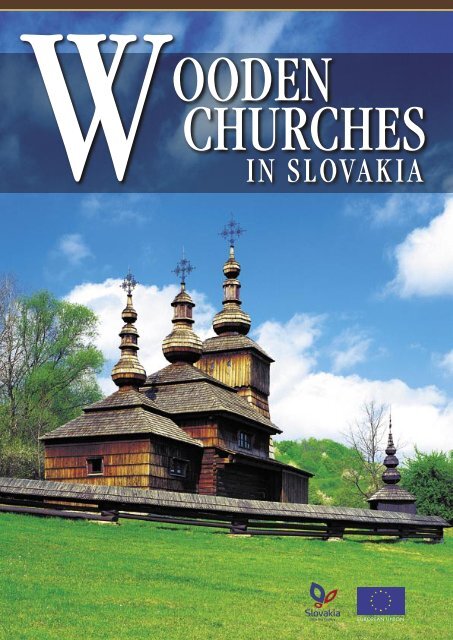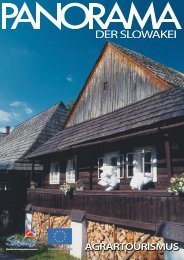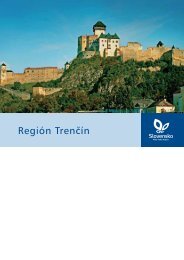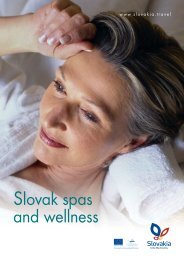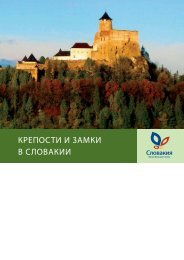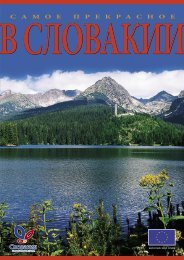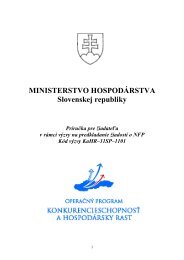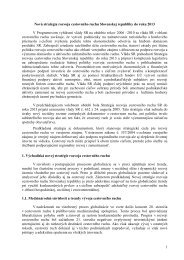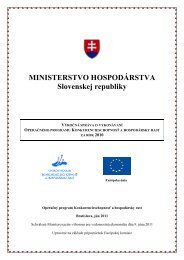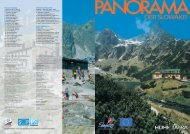Anglická verzia - SACR
Anglická verzia - SACR
Anglická verzia - SACR
You also want an ePaper? Increase the reach of your titles
YUMPU automatically turns print PDFs into web optimized ePapers that Google loves.
W OODEN CHURCHES<br />
I N S L OVA K I A
GEMS OF RELIGIOUS<br />
FOLK WOODEN<br />
ARCHITECTURE<br />
S<br />
lovakia is a hilly country, with thick coniferous and<br />
deciduous forests covering 38% of its area. No doubt that<br />
is one of the reasons why our ancestors came to have such a<br />
feeling for wood and excelled in the use of this natural material.<br />
The traditions of working with wood going back hundreds<br />
of years are most clearly to be seen in tangible form in the<br />
sphere of folk architecture. Even today there are charming<br />
little villages with wooden cottages and a striking wooden<br />
church. For the most part the churches are separate from other<br />
secular buildings, situated on higher ground or in places that<br />
provide natural refuge. They are often in small cemeteries and<br />
surrounded by carved wooden or cast-iron crosses.<br />
Ingenious carpentry techniques were used to build the churches<br />
without any metal or nails. Their style was a fusion of western<br />
and eastern, Byzantine, culture.<br />
Although the overall design of the buildings was determined<br />
by church regulations and religious traditions, the timber<br />
construction of the walls, the domes and other parts were the<br />
work of carpenters, folk craftsmen. Great emphasis was laid on<br />
the interior of the church, which had to be decorated in such a<br />
way as to satisfy the taste of the local population and the artistic<br />
aspect of the church interiors adds to the value of these historical<br />
buildings.<br />
The wooden churches in Slovakia served and still serve a<br />
variety of denominations. They were built by Roman Catholics,<br />
Greek Catholics, as well as Orthodox believers or Protestants.<br />
According to the surviving records, there were originally about<br />
Bratislava<br />
Trnava<br />
Trenčín<br />
Nitra<br />
Čadca<br />
Žilina<br />
1<br />
48<br />
Rajec<br />
43 Ružomberok<br />
Martin<br />
Banská<br />
Bystrica<br />
2<br />
Zvolen<br />
Detva<br />
3<br />
4<br />
47<br />
Dolný Kubín<br />
5<br />
300 wooden religious<br />
buildings here. Many<br />
of them were wiped<br />
out by wars, or they<br />
were built of less<br />
durable wood and<br />
were mercilessly<br />
destroyed by the<br />
ravages of time.<br />
About 50 churches have survived to the present day, mostly<br />
from the 17th to 19th centuries. The greatest concentration of<br />
wooden churches is to be found in the north-east of Slovakia. In<br />
1968 twenty-seven wooden churches in this area were declared<br />
national cultural monuments. Two of them, in Hervartov<br />
and Hraničné, are Roman Catholic and the other twenty-five<br />
served religions of the Eastern rite - Bodružal, Miroľa, Príkra,<br />
Šemetkovce, Potoky, Korejovce, Hunkovce, Krajné Čierno,<br />
Dobroslava, Nižný Komárnik, Ladomirová, Uličské Krivé,<br />
Topoľa, Ruský Potok, Hrabová Roztoka, Kalná Roztoka, Inovce,<br />
Ruská Bystrá, Brežany, Jedlinka, Kožany, Krivé, Tročany, Frička<br />
and Lukov-Venécia.<br />
In recent years the building skill, impressive beauty and perfect<br />
harmony with the surrounding landscape shown in these<br />
religious buildings have inspired people to ensure that the most<br />
valuable of them do not remain just treasures of Slovak cultural<br />
heritage, but are included on the UNESCO List of World Cultural<br />
and Natural Heritage.<br />
45<br />
Liptovský<br />
Mikuláš<br />
Brezno<br />
Poprad<br />
7<br />
8<br />
9<br />
6 Kežmarok<br />
Levoča<br />
Rožňava<br />
44 46<br />
11 13<br />
10 12 14 Svidník<br />
Bardejov<br />
20<br />
15<br />
18 37<br />
16 Stropkov<br />
Prešov<br />
42 Košice<br />
1 TRNOVÉ<br />
13 JEDLINKA<br />
25 BODRUŽAL<br />
2 HRONSEK 14 BARDEJOVSKÉ KÚPELE 26 KRAJNÉ ČIERNO<br />
3 SVÄTÝ KRÍŽ<br />
4 TVRDOŠÍN<br />
5 LEŠTINY<br />
6 KEŽMAROK<br />
7 HRANIČNÉ<br />
8 MATYSOVÁ<br />
15 HERVARTOV<br />
16 TROČANY<br />
17 BREŽANY<br />
18 KOŽANY<br />
19 HUMENNÉ<br />
20 SVIDNÍK<br />
27 HUNKOVCE<br />
28 KOREJOVCE<br />
29 MIROĽA<br />
30 ŠEMETKOVCE<br />
31 KOŽUCHOVCE<br />
32 NOVÁ SEDLICA<br />
9 STARÁ ĽUBOVŇA 21 DOBROSLAVA<br />
33 TOPOĽA<br />
10 LUKOV<br />
11 FRIČKA<br />
12 KRIVÉ<br />
22 LADOMIROVÁ<br />
23 NIŽNÝ KOMÁRNIK<br />
24 PRÍKRA<br />
34 RUSKÝ POTOK<br />
35 ULIČSKÉ KRIVÉ<br />
36 NOVÁ POLIANKA<br />
17<br />
31<br />
36<br />
21<br />
22 23<br />
19<br />
Humenné<br />
Trebišov<br />
24 25<br />
26 27 28<br />
29 30<br />
38<br />
33<br />
34<br />
35<br />
39<br />
41 40<br />
32<br />
37 POTOKY<br />
38 KALNÁ ROZTOKA<br />
39 HRABOVÁ ROZTOKA<br />
40 INOVCE<br />
41 RUSKÁ BYSTRÁ<br />
42 KOŠICE<br />
43 MARTIN<br />
44 ZBOJ<br />
45 ZÁBREŽIE<br />
46 MIKULÁŠOVÁ<br />
47 ZUBEREC<br />
48 RUDNO<br />
ROMAN CATHOLIC<br />
CHURCHES<br />
HERVARTOV<br />
oman Catholic churches form the smallest group of<br />
Rwooden R<br />
religious buildings. They are also among the<br />
oldest, being rare Late Gothic monuments from the end of<br />
the 15th and the beginning of the 16th century. For reasons<br />
of security they are open only during the services, but<br />
visitors interested in seeing inside can phone the relevant<br />
parish office beforehand and they will arrange for local<br />
inhabitants to show them around.<br />
Hervartov – Here there is a little church built at the end<br />
of the 15th century in the spirit of Gothic principles near<br />
Bardejov and dedicated to St. Francis of Assisi. The material<br />
used is red spruce. The interior is divided into two parts and<br />
decorated with wall paintings from 1665. The main altar is<br />
the original one dating back to 1460 – 1470.<br />
All Saints’ Church (Kostol Všetkých svätých) in the local<br />
cemetery in Tvrdošín deserves particular attention. It was<br />
mentioned in the historical annals as long ago as 1551. It<br />
has a remarkable coffered ceiling in the nave of the church,<br />
made up of 49 different ornamental rosettes. In the second<br />
half of the 18th century the church was renovated and a<br />
large Baroque altar added. In 1994 the town of Tvrdošín<br />
was awarded the Europa Nostra prize for the exemplary<br />
restoration of this heritage site.<br />
The oldest Roman Catholic wooden church to survive is<br />
in Trnové near Žilina. It is dedicated to the village’s patron<br />
saint, St. George (sv. Juraj). The earliest written record of<br />
the small Gothic church, which has a single nave and a<br />
large adjoining tower, comes from 1583. It was first built<br />
in the village of Bytčica, but later moved to Trnové, where<br />
it now stands surrounded by the cemetery. Its two large<br />
Renaissance bells are dated 1604 and 1606 and the interior of<br />
the church is from the Baroque period.<br />
Visiting season<br />
Tvrdošín<br />
July – September<br />
Individual bookings in other months.<br />
TRNOVÉ<br />
TVRDOŠÍN<br />
HERVARTOV<br />
10 am – 4 pm<br />
(except Mondays)<br />
HERVARTOV<br />
TVRDOŠÍN<br />
www.snm.sk<br />
www.sacr.sk<br />
Rímskokatolícky farský úrad, Richvald<br />
(Roman Catholic Parish Office)<br />
085 01 Bardejov 1<br />
tel.: + 421-54-479 32 39<br />
Obecný úrad Hervartov, 086 22 Kľušov<br />
(Municipal Office)<br />
tel.: +421-54-472 37 60<br />
MsKS, sídlisko Medvedzie, 027 44 Tvrdošín<br />
tel.:+421-43/532 21 63, 532 21 67<br />
2 3
PROTESTANT “ARTICLED”<br />
CHURCHES<br />
KEŽMAROK KEŽMAROK LEŠTINY HRONSEK<br />
T he remarkable wooden Protestant churches known<br />
as “articled churches” form a special branch of<br />
Protestant architecture. They have a Greek-cross plan and<br />
were built according to articles issued in 1681by Emperor<br />
Leopold I. In this way the absolutist regime of the Austro-<br />
Hungarian Empire hoped to halt the spread of Evangelical<br />
Protestantism. Articled churches had to stand at the edge<br />
of the village or town and they had to be built within one<br />
year. The use of stone and metal was prohibited, wood<br />
being the only material allowed. The churches could not<br />
have foundations, towers or bells and the entrances had<br />
to face away from the village. Separate belfries, adjoining<br />
the churches or standing separate like large prism-shaped<br />
wooden constructions, are an eye-catching feature of these<br />
sites. It was originally planned to build 38 wooden articled<br />
churches in Slovakia, but only nine were actually built and of<br />
these only five have survived.<br />
Svätý Kríž – The oldest articled church from 1773 – 1774,<br />
originally stood in the village of Paludza. When the Liptovská<br />
Mara dam was built the church was moved, restored and reerected<br />
in its original form in 1982 in Svätý Kríž, 14 km from<br />
Liptovský Mikuláš. Covering an area of 658 square metres,<br />
it is one of the largest wooden buildings in central Europe.<br />
It has 12 doors and 72 windows and can accommodate a<br />
congregation of about 6000. The interior furnishings of the<br />
church are simple, showing off to best advantage the beauty<br />
of the fir wood and the patterns made by the natural light<br />
LEŠTINY<br />
ISTEBNÉ<br />
SVÄTÝ. KRÍŽ<br />
HRONSEK<br />
KEŽMAROK<br />
penetrating the interior of the church. Particularly interesting<br />
features include the choir lofts and the paintings on wooden<br />
panels depicting scenes from the Bible interwoven with<br />
animal motifs and flowers. The belfry was built in 1781.<br />
Kežmarok – The Holy Trinity Church (Kostol sv. Trojice)<br />
is the only articled church whose walls are covered with<br />
plaster. It was built in 1717, thanks to a collection in which<br />
Protestants from northern Europe also participated. Swedish<br />
sailors are said to have helped in its construction and that<br />
is why the interior is reminiscent of the upside-down prow<br />
of a ship with round portholes. The church was built of<br />
yew and red spruce without the use of a single piece of<br />
metal. The vaulted ceiling is supported by just four twisting<br />
columns with carved capitals. It is somewhat smaller in<br />
size, accommodating a congregation of 1500. Of particular<br />
interest is the wooden altar from 1727 with rich Baroque<br />
figural and ornamental decoration.<br />
Hronsek – another Protestant church with a belfry near<br />
the town of Banská Bystrica dates back to 1725-1726. It was<br />
built of oak and spruce and has survived into this third<br />
millennium almost unaltered. Here the Greek-cross plan of<br />
articled churches has been reduced and it was intended to<br />
hold no more than 1100 visitors. The church is 8 metres high,<br />
26 metres long and 11 metres wide. It has 30 windows. The<br />
simplicity of the pews and the panel lining to the walls give<br />
the interior a Puritan, Protestant look. The organ from 1764<br />
is still in working order and was made in the workshop of<br />
Master Podkonický. Two of the four enormous lime trees<br />
growing in front of the church are said to have been planted<br />
on the occasion of the consecration of the church.<br />
The articled churches in Istebné from 1686 and Leštiny<br />
from 1688 (near the town of Dolný Kubín in the Orava<br />
region) are smaller, less sophisticated types. They were<br />
built in an area restricted by the terrain and that is why<br />
there is only a hint of the shape of a cross. They are more<br />
like the older tradition of single-nave churches with oblong<br />
ground plans. In contrast to the inconspicuous exterior, their<br />
interiors are surprisingly crammed and over-ornate. The<br />
Leštiny church has been preserved in an almost authentic<br />
form. We can still admire the richly decorated sacristy,<br />
the painted marbled coffers in the ceiling and the illusory<br />
architecture on the walls. Orava’s wooden articled churches<br />
have their own inimitable charm, their artistic expression<br />
being very much influenced by folk traditions.<br />
Visiting hours<br />
Svätý Kríž<br />
1.10. - 31. 5. daily 9 am – 3 pm<br />
1.6. - 30. 9. daily 9 am – 5 pm<br />
Services every Sunday 9 am – 10 am<br />
Kežmarok<br />
1.5. - 30.10.<br />
daily 9 am – 12 am<br />
2 pm – 5 pm<br />
1.11. - 30.4. 8 am – 15 pm<br />
Tuesday, Friday<br />
10 am – 12 am<br />
2 pm – 4 pm<br />
Bookings can be made for organised groups outside the usual<br />
opening hours.<br />
Hronsek<br />
daily 10 am – 5 pm<br />
SVÄTÝ KRÍŽ<br />
SVÄTÝ KRÍŽ<br />
Svätý Kríž<br />
Evanjelický farský úrad Lazisko<br />
(Evangelical Parish Office)<br />
tel: + 421-44- 559 26 22<br />
Cirkevný zbor ECAV na Slovenku<br />
Hviezdoslavova 18, 060 01 Kežmarok<br />
tel./fax: +421-52-452 22 42<br />
Evanjelický farský úrad<br />
Krčméryho 8, Hronsek<br />
tel.: + 421- 48- 418 81 65<br />
Evanjelický farský úrad Istebné<br />
(Evangelical Parish Office)<br />
tel.: +421-43-589 13 53<br />
Evanjelický farský úrad Leštiny<br />
(Evangelical Parish Office)<br />
tel.:+ 421-43-589 51 56<br />
4 5
BREŽANY<br />
FRIČKA<br />
CHURCHES OF<br />
THE EASTERN RITE<br />
T he most numerous group of wooden churches is<br />
that formed by the churches of the Eastern rite. Little<br />
Greek Catholic and Orthodox churches are scattered all<br />
over north-eastern Slovakia in little villages with just a<br />
few dozen inhabitants. The characteristic feature of these<br />
religious buildings is the emphasis on the number three,<br />
symbolising the Holy Trinity. This can be seen not only in<br />
the three domes, but also in the ground plan, with three<br />
areas arranged lengthwise (from west to east). The women<br />
congregated in the babinec [babinets], the area nearest to<br />
the door, the men in the nave - the largest part of the church<br />
– and the sanctuary was for church rites. One striking feature<br />
in the interior was the iconostasis – a wooden screen with<br />
panel paintings, dividing off the altar from the rest of the<br />
church. The arrangement, number and themes of the icons<br />
in it was laid down by the strict rules of the liturgy and the<br />
appeal of the interior was enhanced by the three richly<br />
decorated and carved doors. The middle one, known as<br />
the royal door, was used by the priest, the other two by the<br />
deacons and the lay congregation. Originally the churches<br />
were richly decorated with paintings on the walls and<br />
ceiling, depicting scenes from the Gospels. Churches of the<br />
Eastern rite, known as cerkvi (tserkvas), were mainly built in<br />
the period between the 17th and 19th centuries.<br />
THE PREŠOV DISTRICT<br />
Brežany - St. Luke’s Church (Kostol sv. Lukáša) is the only<br />
wooden church to have been preserved in this district. It<br />
is an eye-catching atypical dark brown building with white<br />
pointing from 1727, standing on higher ground. Originally<br />
JEDLINKA<br />
FRIČKA KRIVÉ<br />
JEDLINKA<br />
LUKOV KOŽANY<br />
TROČANY<br />
BREŽANY<br />
it was used by Greek Catholic congregations, but now<br />
Roman Catholic masses are served there. It is surrounded by<br />
a historical cemetery with iron crosses, many of which are<br />
over a hundred years old.<br />
THE BARDEJOV DISTRICT<br />
Tročany - Not far from Bardejov, the Church of St. Luke<br />
(Cerkva sv. Lukáša) from the end of the 15th century is the<br />
oldest surviving church of the Eastern rite in Slovakia of the<br />
type made of timber and divided into three parts. Sadly, the<br />
unique wood carvings that used to be part of its interior<br />
have not been preserved. The church stands in the middle of<br />
the village, surrounded by wooden cottages.<br />
Jedlinka - The Mother Mary Church (Cerkva Ochrany<br />
Bohorodičky – literally, the Church of the Protection of the<br />
Mother of God). This typical triple-part and triple-dome<br />
church of the Eastern rite was built in 1763. Its impressive<br />
interior decoration includes a Rococo iconostasis, wooden<br />
Baroque candlesticks and above all a rare liturgical book<br />
from the 17th century, printed in Cyrillic.<br />
Kožany - he Church of the Meeting of the Lord with<br />
Simon (Cerkva stretnutia Pána so Simeonom), built in the<br />
second half of the 18th century. The complicated shape of<br />
its shingle roof is of particular interest. In contrast to those<br />
in other churches, the iconostasis from the beginning of<br />
the 18th century has only two doors. The wall paintings<br />
depicting scenes from the Old and New Testament were<br />
added between 1793 and 1797.<br />
Krivé - The Church of the Evangelist Luke (Kostol<br />
evanjelistu Lukáša) from 1826 seems to have defied the<br />
TROČANY<br />
usual strict division of a church of the Eastern rite into<br />
three parts. However there are still three areas in its<br />
interior. The iconostasis consists of paintings from the 17th<br />
and 18th centuries.<br />
Frička – The Church of Michael the Archangel (Kostol<br />
archanjela Michala) with the main dome above the babinec<br />
is one of the best-preserved wooden churches. It was<br />
built in the 18th century. The oldest part of the iconostasis<br />
is from 1830 and the altar from 1716. The interior of the<br />
church was painted in 1933.<br />
Lukov-Venécia – The Church of SS. Cosmas and<br />
Damian (Chrám sv. Kozmu a Damiána) from 1708-1709<br />
is remarkable for its untraditional architecture, making<br />
it unlike other such tserkvas. It is the only one of the<br />
churches to have a cellar and it was built on top of a high<br />
underpinning foundation that compensates for the steep<br />
terrain. The church’s icons are from the 16th and 18th<br />
centuries.<br />
LUKOV-VENÉCIA<br />
Gréckokatolícke biskupstvo<br />
(Greek Catholic Diocese)<br />
Hlavná 1, 081 35 Prešov<br />
tel.: +421-51-773-46-22, fax: +421-51-756 26 25<br />
www.grkatpo.sk<br />
Gréckokatolícky farský úrad<br />
(Greek Catholic Parish Office)<br />
Jiráskova 21, 085 01 Bardejov<br />
tel.: +421-54-472 20 13, 474 89 04<br />
Obecný úrad Tročany<br />
(Municipal Office)<br />
086 41 pošta Raslavice<br />
tel.: +421-54-479 24 05<br />
Gréckokatolícky farský úrad<br />
(Greek Catholic Parish Office)<br />
086 36 Jedlinka<br />
tel.: +421-54-479 90 10<br />
Kožany<br />
Gréckokatolícky farský úrad<br />
090 42 Okrúhle<br />
tel.: +421-54-759 11 31, 759 14 55<br />
Gréckokatolícky farský úrad<br />
(Greek Catholic Parish Office)<br />
Krivé, 086 04 Kružlov<br />
tel.: +421-54-479 5241<br />
Gréckokatolícky farský úrad<br />
(Greek Catholic Parish Office)<br />
Frička, 086 02 Gaboltov<br />
tel.: +421-54-479 43 23<br />
Gréckokatolícky farský úrad<br />
(Greek Catholic Parish Office)<br />
086 05 Lukov pri Bardejove<br />
tel.: +421-54-476 62 34<br />
6 7
BODRUŽAL KALNÁ ROZTOKA ULIČSKÉ KRIVÉ<br />
THE SNINA DISTRICT<br />
Uličské Krivé – The Church of Michael the Archangel<br />
(Cerkva archanjela Michala) from 1718 is a tourist attraction<br />
in the middle of the village. Its large and complicated shingle<br />
roof makes it one of the most impressive churches of its kind.<br />
It has a richly decorated Baroque interior and some of the<br />
icons date back to the 16th century.<br />
Topoľa – The little Church of Michael the Archangel<br />
(Kostolík archanjela Michala) was built by its congregation<br />
around 1700 on a hill overlooking the village. Surrounded by<br />
an old cemetery, it is one of the oldest wooden churches of the<br />
Eastern rite.<br />
Visiting hours<br />
Uličské Krivé<br />
Monday - Saturday<br />
9 am – 5 pm<br />
Ruský Potok – Another church dedicated to the archangel<br />
Michael, who was clearly particularly venerated in the<br />
Poloniny area. The church was built in 1740 and its iconostasis<br />
is the original one. Ruský Potok also attracts visitors on<br />
account of its valuable liturgical documents printed in Cyrillic<br />
from the mid 17th century.<br />
Kalná Roztoka – The Church of St. Basil the Great (Cerkva<br />
sv. Bazila Veľkého) from the end of the 18th century, restored<br />
in 1839, looks like a masonry building, as the outside is<br />
covered in whitewashed clay. Inside there is an 18th century<br />
iconostasis and an icon of Christ from 1773. Within the grounds<br />
surrounded by a fence there is also a 20th century belfry.<br />
Hrabová Roztoka – An interesting feature of the Church of<br />
St. Basil the Great (Cerkva sv. Bazila Veľkého) from the middle<br />
of the 18th century is the panelling of the walls both on the<br />
inside and outside of the church. An untraditional cupboard in<br />
Gothic style is part of the otherwise Baroque interior.<br />
THE SVIDNÍK DISTRICT<br />
Bodružal – The Church of St. Nicholas (Cerkva sv.<br />
Mikuláša) is one of the most beautiful and oldest of the<br />
churches of the Eastern rite in Slovakia. It was built in 1658<br />
and recently completely reconstructed. This large building,<br />
divided into three areas and dominated by three onion<br />
domes of varying heights, stands out in the southern part of<br />
the village. It is surrounded by a wooden fence with a little<br />
shingle roof and an entrance gate. In the nineteen nineties<br />
the white and gold Baroque interior of the church was<br />
renovated and the iconostasis and altar restored.<br />
Miroľa – The Mother Mary Church (Cerkva Ochrany<br />
Bohorodičky) is the main landmark in this little village in east<br />
Slovakia. It has been preserved in almost the original form<br />
since 1770. Below the iconostasis with four rows of icons<br />
there is a striking, richly decorated royal door, which is used<br />
exclusively by the priest when passing from the nave to the altar.<br />
RUSKÝ POTOK<br />
BODRUŽAL<br />
MIROĽA<br />
TOPOĽA<br />
RUSKÝ POTOK<br />
ULIČSKÉ KRIVÉ<br />
KALNÁ ROZTOKA<br />
HRABOVÁ ROZTOKA<br />
KALNÁ ROZTOKA<br />
MIROĽA<br />
MIROĽA<br />
Obecný úrad Uličské Krivé, 053 71 Uličské Krivé<br />
(Municipal Office)<br />
tel.:+421-57-769 41 81<br />
Obecný úrad Topoľa, 067 65 Topoľa<br />
(Municipal Office)<br />
tel.:+421-57-769 81 19<br />
Obecný úrad Ruský Potok, 067 66 Ruský Potok<br />
(Municipal Office)<br />
tel.:+421-57-769 81 21<br />
Obecný úrad Kalná Roztoka, 067 72 Kalná Roztoka<br />
(Municipal Office)<br />
tel.:+421-57-769 61 48<br />
8 9
KOREJOVCE<br />
HUNKOVCE<br />
A further three wooden churches were dedicated to the<br />
archangel Michael in the villages of Príkra (from 1777),<br />
Šemetkovce (from 1752) and Ladomirová (from 1742),<br />
which is unusual in that it was built without the use of a single<br />
nail. It is surrounded by a cemetery with interesting wooden,<br />
metal and stone crosses. An iconostasis with five rows of icons<br />
and an altar from the middle of the 18th century, as well as<br />
other liturgical objects are valuable cultural relics.<br />
Korejovce – The Mother Mary Church (Chrám Ochrany<br />
Bohorodičky) dates back to 1764. Unfortunately the<br />
iconostasis has not survived intact. Inside the church there<br />
are interesting plant decorations on the royal door. Near to<br />
the church there is a wooden belfry that has three bells dating<br />
1769, 1771 and 1835.<br />
Nižný Komárnik – Here you can find one of the most<br />
impressive, but also one of the most recently built of the<br />
wooden tserkvas (cerkva) in north-eastern Slovakia. The<br />
Mother Mary Church (Chrám Ochrany Bohorodičky) from<br />
1938 was designed by the outstanding Ukrainian architect and<br />
researcher into folk architecture V. Sichynsky (1894-1962).<br />
Hunkovce – The Church of the Decease of the Mother of<br />
God (Cerkva Zosnutia Bohorodičky) is from the end of the<br />
18th century. Three domes of varying heights are crowned by<br />
poppyhead-shaped constructions and ornamental crosses.<br />
The church is surrounded by a cemetery and can be seen only<br />
from the outside. It is no longer in use.<br />
NIŽNÝ KOMÁRNIK LADOMIROVÁ<br />
PRÍKRA<br />
KOREJOVCE<br />
HUNKOVCE<br />
ŠEMETKOVCE<br />
NIŽNÝ KOMÁRNIK<br />
NIŽNÝ KOMÁRNIK<br />
LADOMIROVÁ<br />
ŠEMETKOVCE<br />
KOREJOVCE<br />
ŠEMETKOVCE<br />
Korejovce and Nižný Komárnik<br />
Gréckokatolícky farský úrad (Greek Catholic Parish Office) Krajná Bystrá<br />
tel.:+421-54-759 33 30<br />
1 0 1 1
INOVCE<br />
KRAJNÉ ČIERNO<br />
Krajné Čierno – The 18th century Church of St. Basil the<br />
Great (Cerkva sv. Bazila Veľkého) has an atypical Baroque<br />
iconostasis with just two doors, above which hang pictures<br />
depicting scenes from the New Testament. Not only the roof,<br />
but also the timber walls of the building are covered with<br />
shingles.<br />
Dobroslava – the core of the Church of St. Paraskieva is its<br />
oldest part, dating back to 1705. Following alterations in 1880<br />
and 1932 it now has a ground plan in the shape of a cross.<br />
The most striking feature in the interior is the 18th century<br />
iconostasis, which has restored icons on themes from the New<br />
Testament.<br />
THE SOBRANCE DISTRICT<br />
Inovce – the Church of Michael the Archangel (Kostol<br />
archanjela Michaela) in this east-Slovakian village, almost on<br />
the Ukrainian border, has two striking towers. It dates back to<br />
1836. A “Pieta” signed by Michal Mankovič in 1842 forms part<br />
of the iconostasis from the middle of the 19th century.<br />
Ruská Bystrá - the hexagonal altar space in St. Nicholas’s<br />
Church (Kostolík sv. Mikuláša) is particularly interesting. The<br />
roof of this church with two domes makes it look more like a<br />
peasant’s cottage than a tserkva. It was built at the beginning<br />
of the 18th century and its Baroque and Rococo interior also<br />
comes from the same period.<br />
HRANIČNÉ DOBROSLAVA<br />
KRAJNÉ ČIERNO<br />
POTOKY<br />
INOVCE<br />
RUSKÁ BYSTRÁ<br />
THE STROPKOV DISTRICT<br />
Potoky – The Church of St. Paraskieva (Chrám sv.<br />
Paraskievy) was built on an eastern slope of the village in<br />
1773. The interior and its iconostasis with three rows of<br />
icons also comes from this period. The visitor’s attention is<br />
drawn to the fragments of wall paintings with plant motifs.<br />
The separate belfry is from 1839.<br />
THE STARÁ ĽUBOVŇA DISTRICT<br />
Hraničné – The Church of the Immaculate Conception<br />
of the Virgin Mary (Cerkva Nepoškvrneného počatia Panny<br />
Márie) from 1785 is used for Roman Catholic religious<br />
services, as well as those of the Eastern rite. In the second<br />
half of the 19th century it was reconstructed and nowadays<br />
sacral relics in a variety of historical styles can be seen in its<br />
interior.<br />
DOBROSLAVA<br />
RUSKÁ BYSTRÁ KRAJNÉ ČIERNO POTOKY HRANIČNÉ DOBROSLAVA<br />
Dobroslava<br />
Gréckokatolícky farský úrad (Greek Catholic Parish Office) Kapišová<br />
tel: +421-54-752 25 93<br />
1 2 1 3
RELIGIOUS BUILDINGS IN<br />
OPEN-AIR MUSEUMS<br />
ZBOJ ZÁBREŽIE MATYSOVÁ<br />
I n order to protect them and possibly use them for their<br />
original purpose, some churches have been moved to<br />
new sites, most of them to open-air museums. St. Nicholas’<br />
Church (kostolík sv. Mikuláša) from 1775 was moved to<br />
the Šariš Museum’s open-air exhibition in Bardejov Spa<br />
from Zboj in the easternmost valley in Slovakia. A church<br />
dedicated to the Holy Mother of God from the village of<br />
Mikulášová – Nikľová near Bardejov was also moved here in<br />
ZUBEREC<br />
MARTIN<br />
KOŽUCHOVCE<br />
BARDEJOVSKÉ<br />
KÚPELE SVIDNÍK<br />
STARÁ<br />
ĽUBOVŇA<br />
HUMENNÉ<br />
KOŠICE<br />
1926 – 1931. On a beam in the now renovated church there<br />
is an inscription from 1730. It is one of the few churches to<br />
have decorative wall paintings. Greek-Catholic services are<br />
held here on a regular basis. Ever since 1927 visitors have<br />
been able to view a church that came from the village of<br />
Kožuchovce near Stropkov, now standing in the grounds<br />
of the Museum of East Slovakia in Košice. It was built<br />
in 1741 from fir, with part of the iconostasis being carved<br />
out of linden. Unfortunately, incorrect techniques were<br />
used for the reconstruction of the interior, which led to the<br />
disappearance of the wall paintings.<br />
Ľubovnianske múzeum in Stará Ľubovňa has become<br />
the new home of the Church of St. Michael the Archangel<br />
(Cerkva sv. Archanjela Michala) from Matysová. The church<br />
from the second half of the 18th century has a rare altar<br />
picture of the Mother of God dated 1693. After being newly<br />
consecrated in 1990, services of the Eastern rite take place<br />
here on important church feast days. A church from Nová<br />
Polianka dated 1766 and dedicated to St. Paraskieva has<br />
found its way to the Museum of Ukrainian-Ruthenian Culture<br />
in Svidník. Since being consecrated once more in 1993 it<br />
has served for occasional religious services. The Vihorlat<br />
Museum’s open-air exhibition in Humenné acquired<br />
the Church of Michael the Archangel (Kostol archanjela<br />
Michala) from Nová Sedlica in 1977. It dates back to 1794<br />
and has a valuable Baroque iconostasis and a bell in its<br />
tower from 1811. In the Orava Village Museum we can see<br />
St. Elizabeth’s Church from Zábrežie dated 1647, which has<br />
an interesting Late Gothic painted ceiling with impressive<br />
flower ornamentation. Finally, in the Slovak Village Museum<br />
in Martin there is a rebuilt Church of Stephen the King<br />
(Kostol Štefana – kráľa) from the village of Rudno, in which<br />
wedding ceremonies are also held.<br />
MATYSOVÁ<br />
ZBOJ<br />
NOVÁ SEDLICA<br />
NOVÁ POLIANKA<br />
Múzeum slovenskej dediny - Martin<br />
Slovak Village Museum<br />
tel.: +421-43-413 26 86, 423 94 91, 422 06 12<br />
fax: +421-43-413 26 86<br />
Múzeum oravskej dediny - Zuberec<br />
Orava Village Museum<br />
tel.: +421-43-539 51 49<br />
www.zuberec.sk<br />
Šarišské múzeum - Bardejovské Kúpele<br />
Šariš Museum<br />
tel.: +421-54-472 20 72<br />
www.muzeumbardejov.sk<br />
Ľubovnianske múzeum - Stará Ľubovňa<br />
Ľubovňa Museum<br />
tel.: +421-52-432 24 22, 432 20 30, 432 3982,<br />
fax: +421-52-432 23 02, www.muzeumsl.sk<br />
SNM - Múzeum ukrajinsko<br />
– rusínskej kultúry, Svidník<br />
Open-Air Museum<br />
of Ruthenian-Ukrainian Culture<br />
tel.: +421-54-752 29 52, www.muk.sk<br />
Vihorlatské múzeum - Humenné<br />
Vihorlat Museum<br />
tel.: +421-57-775 22 40<br />
1 4 1 5
SLOVAK TOURIST BOARD OFFICES ABROAD<br />
© SLOVAK TOURIST BOARD<br />
SLOVENSKÁ AGENTURA PRO CESTOVNÍ RUCH<br />
JILSKÁ 16, 110 00 PRAHA 1, ČESKÁ REPUBLIKA<br />
TEL.: +420 2 249 46 082, FAX: +420 2 249 46 082<br />
E-MAIL: <strong>SACR</strong>PRAHA@SEZNAM.CZ<br />
NARODOWE CENTRUM TURYSTYKI SLOWACKIEJ<br />
UL. KRAKOWSKIE PRZEDMIESCIE 13 POK.17<br />
00-071 WARSZAWA, POLSKA<br />
TEL.: +48 22 827 00 09, FAX: +48 22 827 00 09<br />
E-MAIL: <strong>SACR</strong>@POCZTA.ONET.PL<br />
SLOWAAKS VERKEERSBUREAU<br />
WTC AMSTERDAM, STRAWINSKYLAAN 623<br />
1077 XX AMSTERDAM, NEDERLAND<br />
TEL.: +31 20 575 2181, FAX: +31 20 575 2182<br />
E-MAIL: INFO@SLOWAAKS-VERKEERSBUREAU.NL<br />
WWW.SLOWAAKS-VERKEERSBUREAU.NL<br />
SLOVENSKÁ AGENTÚRA PRE CESTOVNÝ RUCH<br />
NÁM. Ľ. ŠTÚRA 1, P.O.BOX 35<br />
974 05 BANSKÁ BYSTRICA, SLOVENSKÁ REPUBLIKA<br />
TEL: +421 48 413 61 46, FAX: +421 48 413 61 49<br />
E-MAIL: <strong>SACR</strong>@<strong>SACR</strong>.SK, WWW.SLOVAKIATOURISM.SK<br />
BRANCH OFFICE BRATISLAVA<br />
ZÁHRADNÍCKA 153, P.O. BOX 97<br />
820 05 BRATISLAVA 25, SLOVENSKÁ REPUBLIKA<br />
TEL: +421 2 507 00 801, FAX: +421 2 555 71 649<br />
E-MAIL: <strong>SACR</strong>BA@<strong>SACR</strong>.SK, WWW.SLOVAKIATOURISM.SK<br />
REGIONAL OFFICE<br />
REIMANNOVA 9<br />
080 01 PREŠOV<br />
TEL./FAX: +421 51 756 03 61<br />
E-MAIL: PRESOV@<strong>SACR</strong>.SK, WWW.SLOVAKIATOURISM.SK<br />
СЛОВАЦКОЕ УПРАВЛЕНИЕ ПО ТУРИЗМУ<br />
ПОСОЛЬСТВО СЛОВЦКОЙ РЕСПУБЛИКИ<br />
УЛ. ФУЧИКА 17/19, 123 056 МОСКВА,<br />
РОССИЙСКАЯ ФЕДЕРАЦИЯ<br />
ТЕЛ.: 007 495 251 76 31, ФАКС: 007 495 251 76 45<br />
E-MAIL: <strong>SACR</strong>MOW@COMAIL.RU<br />
SLOVAKISCHE ZENTRALE FÜR TOURISMUS<br />
PRINZ-EUGEN-STR. 70, STIEGE 2, 1.STOCK<br />
1040 WIEN, ÖSTERREICH<br />
TEL.: +43 1 513 9569, FAX: +43 1 513 9763<br />
E-MAIL: <strong>SACR</strong>-WIEN@AON.AT<br />
SLOWAKISCHE ZENTRALE FÜR TOURISMUS<br />
VERTRETUNG DEUTSCHLAND<br />
ZIMMERSTRASSE 27, 10969 BERLIN, DEUTSCHLAND<br />
TEL.: +49 30 25 94 26 40, FAX: +49 30 25 94 26 41<br />
E-MAIL: <strong>SACR</strong>-BERLIN@BOTSCHAFT-SLOWAKEI.DE<br />
E-MAIL: TOURISMUS@BOTSCHAFT-SLOWAKEI.DE<br />
EDITORIAL BOARD<br />
SILVIA ŠULEKOVÁ KOLLÁRIKOVÁ (CHAIRPERSON)<br />
KAMILA HANÁKOVÁ<br />
DANIEL KOLLÁR<br />
VIERA DVOŘÁKOVÁ<br />
GABRIELA UŽOVIČOVÁ<br />
ROBERT BUNČA<br />
EDITOR -IN-CHIEF<br />
BEDRICH SCHREIBER<br />
PHOTOGRAPHS<br />
BOART, D. DUGAS, A. JIROUŠEK, A. VOJČEK<br />
GRAPHIC LAYOUT AND PUBLISHING<br />
REMARK/CMA S.R.O.<br />
ROZMARÍNOVÁ 31, 821 04 BRATISLAVA<br />
TEL.: +421 2 434 153 60-62, FAX: +421 2 434 153 59<br />
WWW.REMARK.SK<br />
MINISTRY OF ECONOMY SR<br />
GOVERNING BODY FOR THE SECTOR OPERATIONAL PROGRAMME<br />
INDUSTRY AND SERVICES<br />
MIEROVÁ 19<br />
827 15 BRATISLAVA<br />
SLOVENSKÁ REPUBLIKA<br />
E-MAIL: SOPER@ECONOMY.GOV.SK<br />
WWW.ECONOMY.GOV.SK<br />
ENGLISH TRANSLATION<br />
HEATHER TREBATICKÁ<br />
COVER PICTURES<br />
THE CHURCH FROM NOVÁ POLIANKA IN THE MUSEUM<br />
OF UKRAINIAN-RUTHENIAN CULTURE IN SVIDNÍK<br />
W OODEN<br />
CHURCHES<br />
I N S L OVA K I A<br />
PUBLISHED WITH THE SUPPORT OF THE EUROPEAN UNION


